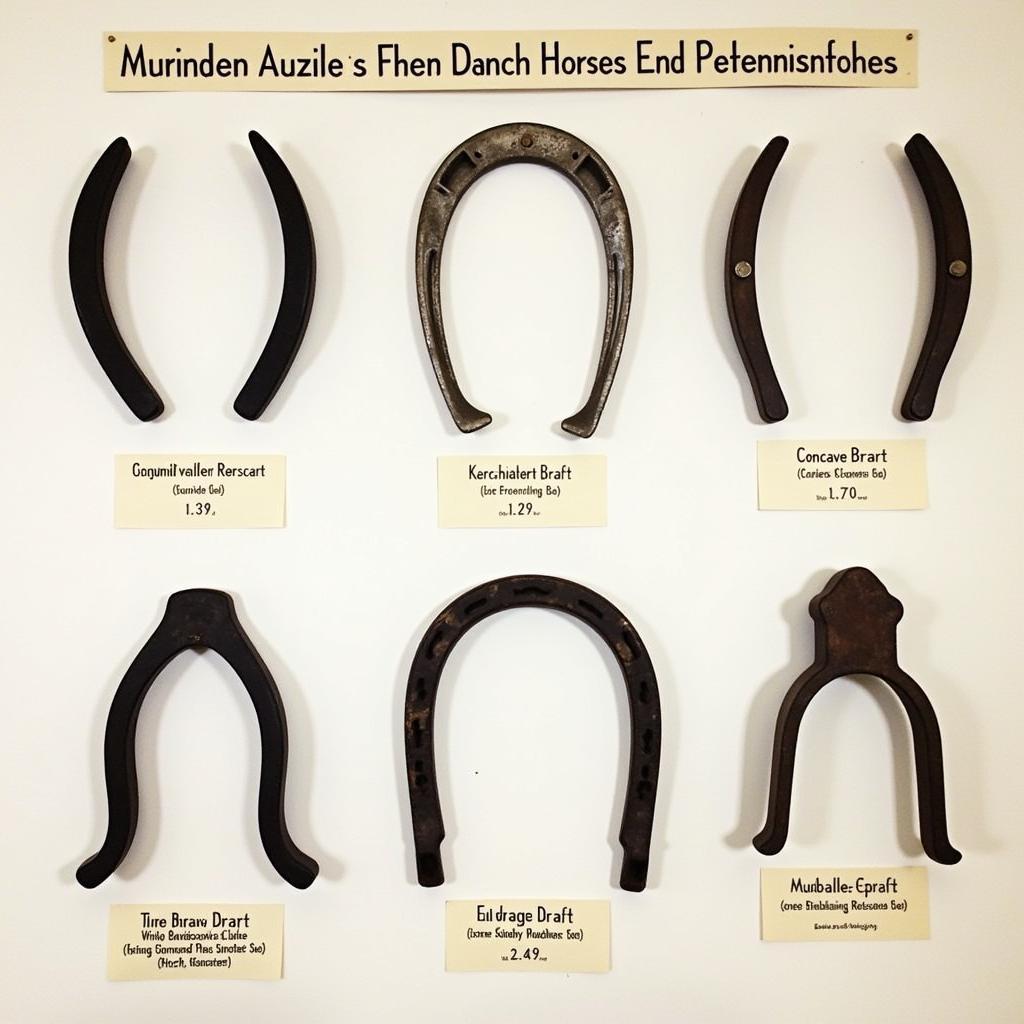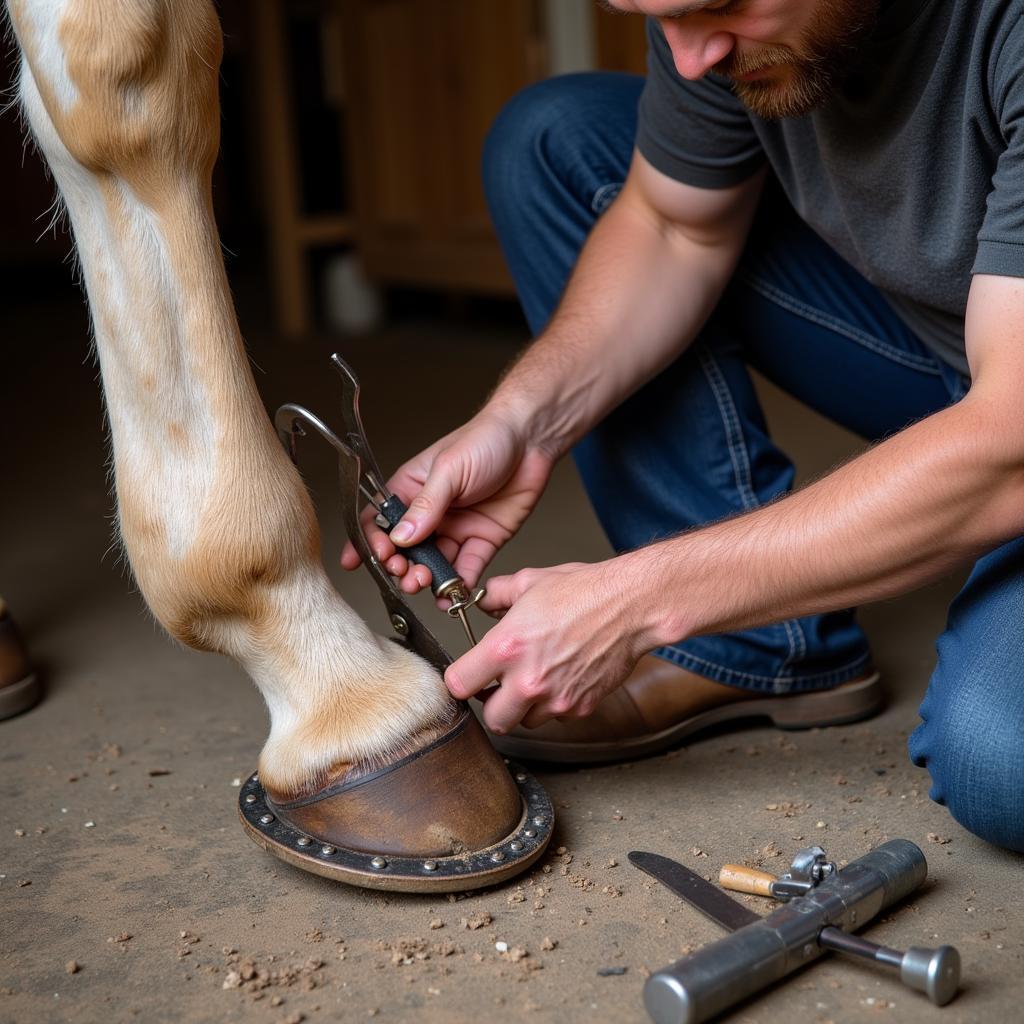Draft Horse Horseshoes are an essential aspect of caring for these gentle giants. Proper hoof care, including choosing and fitting the right horseshoes, is crucial for maintaining their health, soundness, and overall well-being. This comprehensive guide will delve into the specifics of draft horse horseshoes, addressing everything from choosing the right size and type to understanding the shoeing process.
Understanding the Importance of Draft Horse Horseshoes
Draft horses, known for their strength and size, put tremendous pressure on their hooves. Horseshoes protect the hoof wall from excessive wear and tear, providing support and traction, especially on hard or uneven surfaces. They also help to correct hoof imbalances and address specific gait issues. Without proper shoeing, draft horses are at risk of developing a variety of hoof problems, which can lead to lameness and impact their ability to work. For more insights on potential hoof issues, you might find our article on navicular x ray horse helpful.
Choosing the Right Draft Horse Horseshoes
 Different Types of Draft Horse Horseshoes
Different Types of Draft Horse Horseshoes
Selecting the correct horseshoes for a draft horse requires careful consideration of several factors. The size and weight of the horse, its intended workload, and the terrain it works on will all influence the type of shoe chosen. Heavier shoes are generally preferred for draft horses due to their size and the heavy work they perform. These shoes offer increased durability and support. Different materials are also available, including steel, aluminum, and composite materials. Each material has its own advantages and disadvantages in terms of weight, durability, and traction. For instance, steel shoes are known for their strength, while aluminum shoes are lighter, reducing strain on the horse’s legs.
The Draft Horse Shoeing Process
 Farrier Shoeing a Draft Horse
Farrier Shoeing a Draft Horse
Shoeing a draft horse is a specialized skill that requires a qualified farrier. The process involves trimming the hoof, shaping the shoe to fit the hoof precisely, and securely attaching it with nails. The farrier must carefully balance the hoof to ensure even weight distribution and prevent lameness. Regular trimming and shoeing, typically every 6-8 weeks, are essential for maintaining healthy hooves and preventing problems. If you’re interested in learning more about draft horse activities, our page on draft horse pulling events might be of interest.
“A well-shod horse is a happy horse,” says renowned farrier, John Stevenson. “Proper shoeing not only protects the hooves but also enhances the horse’s performance and overall well-being.”
Common Draft Horse Horseshoeing Concerns
Just like any other horse, draft horses can experience hoof problems. These can range from cracked hooves and abscesses to more serious conditions like navicular disease. Regular farrier visits can help prevent and address these issues early on.
“Early detection is key when it comes to hoof problems,” adds Stevenson. “Regular check-ups and prompt treatment can prevent minor issues from becoming major ones.” Perhaps our article on horse nails can offer additional information.
Conclusion
Draft horse horseshoes are an integral part of maintaining the health and soundness of these powerful animals. Selecting the appropriate shoes and ensuring they are correctly fitted by a qualified farrier are essential for their well-being and longevity. This care allows them to continue their valuable work and remain comfortable in their daily activities. Remember, horse key chains make great gifts for fellow horse lovers. Perhaps you’d also be interested in horse panel quilt ideas?
FAQ
- How often should draft horses be shod? Typically every 6-8 weeks.
- What are draft horse shoes made of? Commonly steel or aluminum.
- Why are horseshoes important for draft horses? They provide protection, support, and traction.
- Can draft horses go barefoot? In some cases, yes, but it depends on their workload and environment.
- What are some common hoof problems in draft horses? Cracked hooves, abscesses, and navicular disease.
- How can I tell if my draft horse needs new shoes? Signs include worn shoes, overgrown hooves, and lameness.
- How do I find a qualified farrier? Ask your veterinarian or other horse owners for recommendations.
When you need support, please contact Phone Number: 0772127271, Email: [email protected] Or visit: QGM2+WX2, Vị Trung, Vị Thuỷ, Hậu Giang, Việt Nam. We have a 24/7 customer service team.